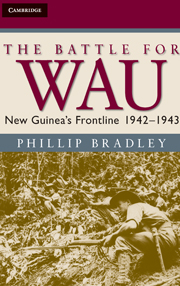Book contents
- Frontmatter
- Dedication
- Contents
- List of illustrations
- Foreword by Peter Ryan
- Acknowledgements
- Prologue
- 1 Salamaua Falls
- 2 Commandos
- 3 Scorched earth
- 4 Undermined
- 5 Convoy
- 6 Assault on Mubo
- 7 17th Brigade
- 8 ‘They came like the rain’
- 9 ‘Life blood of green’
- 10 Force of arms
- 11 Lost airmen
- 12 Retreat from Wau
- Conclusion
- Notes
- Abbreviations
- Bibliography
- Index
8 - ‘They came like the rain’
Published online by Cambridge University Press: 05 February 2014
- Frontmatter
- Dedication
- Contents
- List of illustrations
- Foreword by Peter Ryan
- Acknowledgements
- Prologue
- 1 Salamaua Falls
- 2 Commandos
- 3 Scorched earth
- 4 Undermined
- 5 Convoy
- 6 Assault on Mubo
- 7 17th Brigade
- 8 ‘They came like the rain’
- 9 ‘Life blood of green’
- 10 Force of arms
- 11 Lost airmen
- 12 Retreat from Wau
- Conclusion
- Notes
- Abbreviations
- Bibliography
- Index
Summary
The track up to Wandumi Ridge from Kaisenik follows an intersecting spur that meets Wandumi Ridge high above the Bulolo River valley. Clearly visible from this spur, across what is essentially open ground, is another ridge to the southeast and, beyond that, the higher ridges around Ballam's. My local guide, Ninga, was telling me the stories that his father had told him of the war. At that time the Kaisenik villagers had sensed that the Japanese were coming and had left Kaisenik to head up into the mountains. On 28 January, seeing the Japanese troops moving past them towards Wau, they had come down and assembled on the adjacent ridge. Like spectators at a sporting contest, the Kaisenik villagers looked across onto Wandumi Ridge as the battle developed. I asked whether many Japanese soldiers had come that day and Ninga told me what his father had said: ‘They came like the rain’.
In line with Colonel Maruoka's optimistic plans to capture Wau by dawn, the advanced Japanese forces had assembled at the Trig Point on the late afternoon of 27 January. According to the Japanese history, the first units of Lieutenant-Colonel Shosaku Seki's 2nd Battalion had gathered there at 1530. Okabe and Maruoka finally reached the location around 1700, at which time they made their first observations of Wau through binoculars. A plan of the area was sketched and final plans were made by Maruoka and his battalion commanders Seki and Shimomura.
- Type
- Chapter
- Information
- The Battle for WauNew Guinea's Frontline 1942–1943, pp. 136 - 165Publisher: Cambridge University PressPrint publication year: 2008



